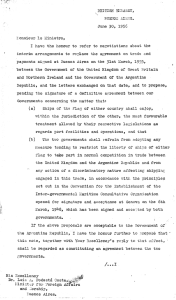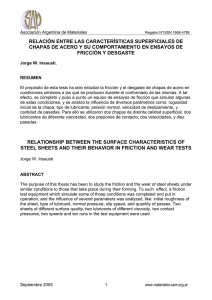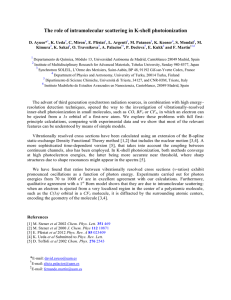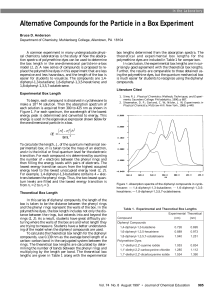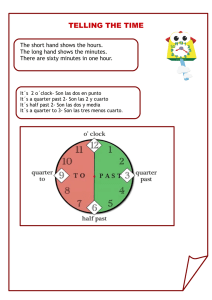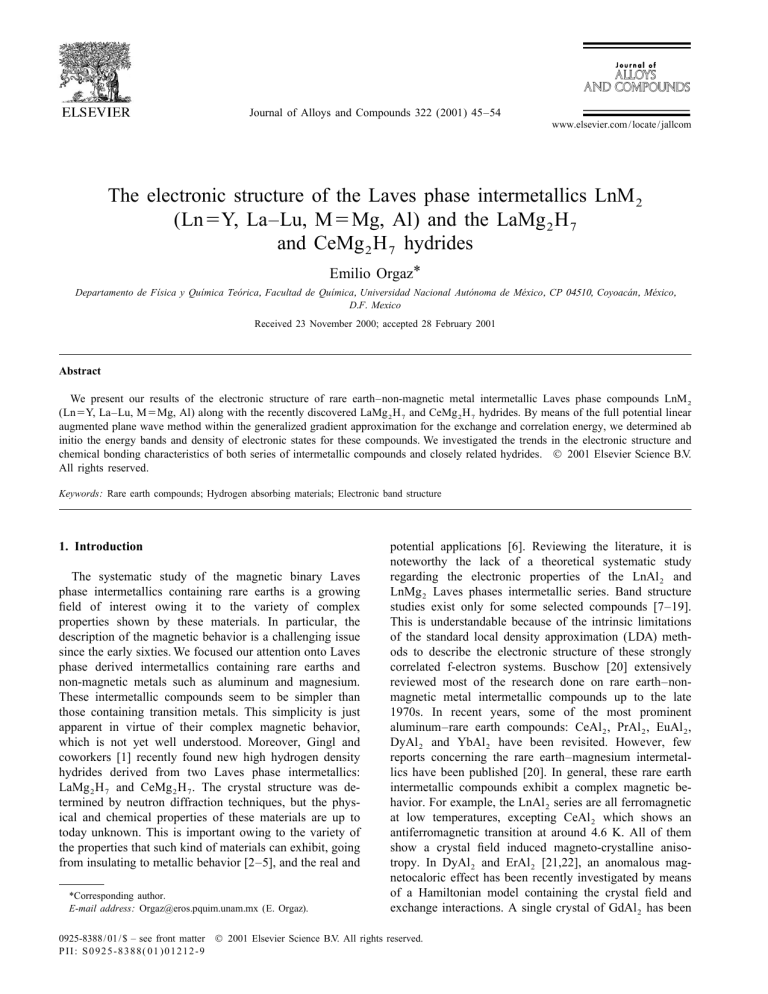
Journal of Alloys and Compounds 322 (2001) 45–54 L www.elsevier.com / locate / jallcom The electronic structure of the Laves phase intermetallics LnM 2 (Ln5Y, La–Lu, M5Mg, Al) and the LaMg 2 H 7 and CeMg 2 H 7 hydrides Emilio Orgaz* ´ ´ ´ ´ ´ ´ ´ , Mexico ´ , Facultad de Quımica , Universidad Nacional Autonoma de Mexico , CP 04510, Coyoacan , Departamento de Fısica y Quımica Teorica D.F. Mexico Received 23 November 2000; accepted 28 February 2001 Abstract We present our results of the electronic structure of rare earth–non-magnetic metal intermetallic Laves phase compounds LnM 2 (Ln5Y, La–Lu, M5Mg, Al) along with the recently discovered LaMg 2 H 7 and CeMg 2 H 7 hydrides. By means of the full potential linear augmented plane wave method within the generalized gradient approximation for the exchange and correlation energy, we determined ab initio the energy bands and density of electronic states for these compounds. We investigated the trends in the electronic structure and chemical bonding characteristics of both series of intermetallic compounds and closely related hydrides. 2001 Elsevier Science B.V. All rights reserved. Keywords: Rare earth compounds; Hydrogen absorbing materials; Electronic band structure 1. Introduction The systematic study of the magnetic binary Laves phase intermetallics containing rare earths is a growing field of interest owing it to the variety of complex properties shown by these materials. In particular, the description of the magnetic behavior is a challenging issue since the early sixties. We focused our attention onto Laves phase derived intermetallics containing rare earths and non-magnetic metals such as aluminum and magnesium. These intermetallic compounds seem to be simpler than those containing transition metals. This simplicity is just apparent in virtue of their complex magnetic behavior, which is not yet well understood. Moreover, Gingl and coworkers [1] recently found new high hydrogen density hydrides derived from two Laves phase intermetallics: LaMg 2 H 7 and CeMg 2 H 7 . The crystal structure was determined by neutron diffraction techniques, but the physical and chemical properties of these materials are up to today unknown. This is important owing to the variety of the properties that such kind of materials can exhibit, going from insulating to metallic behavior [2–5], and the real and *Corresponding author. E-mail address: [email protected] (E. Orgaz). potential applications [6]. Reviewing the literature, it is noteworthy the lack of a theoretical systematic study regarding the electronic properties of the LnAl 2 and LnMg 2 Laves phases intermetallic series. Band structure studies exist only for some selected compounds [7–19]. This is understandable because of the intrinsic limitations of the standard local density approximation (LDA) methods to describe the electronic structure of these strongly correlated f-electron systems. Buschow [20] extensively reviewed most of the research done on rare earth–nonmagnetic metal intermetallic compounds up to the late 1970s. In recent years, some of the most prominent aluminum–rare earth compounds: CeAl 2 , PrAl 2 , EuAl 2 , DyAl 2 and YbAl 2 have been revisited. However, few reports concerning the rare earth–magnesium intermetallics have been published [20]. In general, these rare earth intermetallic compounds exhibit a complex magnetic behavior. For example, the LnAl 2 series are all ferromagnetic at low temperatures, excepting CeAl 2 which shows an antiferromagnetic transition at around 4.6 K. All of them show a crystal field induced magneto-crystalline anisotropy. In DyAl 2 and ErAl 2 [21,22], an anomalous magnetocaloric effect has been recently investigated by means of a Hamiltonian model containing the crystal field and exchange interactions. A single crystal of GdAl 2 has been 0925-8388 / 01 / $ – see front matter 2001 Elsevier Science B.V. All rights reserved. PII: S0925-8388( 01 )01212-9 46 E. Orgaz / Journal of Alloys and Compounds 322 (2001) 45 – 54 investigated by NMR techniques [23], where the anisotropy of the magnetic hyperfine interaction for Al has been determined, and the role of orbital polarization of the conduction electrons has been discussed. LnM 2 compounds shown systematically a large electronic specific heat coefficient. For example, for CeAl 2 g 5274 mJ K 22 22 mole [24,25], for YbAl 2 g 516.8 mJ K -mole [26], for 22 LuAl 2 , g 55.6 mJ K -mole [27]. In this article we present our systematic investigation of the electronic structure of the LnM 2 (Ln5Y, La–Lu, M5Mg, Al) series of compounds along with the recently discovered hydrides LaMg 2 H 7 and CeMg 2 H 7 . In the following sections we will outline the essentials of the computation method. Next, we will describe the most important aspects of the electronic structure of this family of compounds. in the localized f states [13,15]. In our study, we neglect this interaction mainly due to the lack of information about the magnetic moment orientation with respect to the lattice for both series of compounds. Self-interaction corrections (SIC) [30] to the LSD approximation are not yet implemented in the LAPW code. However, it seems that the GGA to the exchange and correlation energy yield similar results to those obtained within the LSD-SIC approach. This is at least true for elemental Pr as quoted by Svane et al. [30]. Spin polarizations were introduced from the beginning of the iterative calculations without any particular choice for the atomic magnetic moment. Finally, it is important to note that the convergence scheme necessitate a small mixing parameter owing to the strong sensitivity of the f-bands occupancies. 3. Results 2. Calculation details We have computed the electronic energy bands of the complete series LnM 2 (Ln5Y, La–Lu; M5Al, Mg) and recently discovered LaMg 2 H 7 and CeMg 2 H 7 hydrides, by means of the full potential-linear augmented plane waves (FPLAPW) method [28]. The total density of states (DOS) as well as the angular momentum resolved DOS at each atomic site were computed. The exchange part of the crystal potential was modeled by means of the generalized gradient approximation (GGA) [29] to the local spin density (LSD) theory. Samples of 120 k-points of the irreducible wedges of the face centered cubic (fcc) and hexagonal Brillouin zones were selected. For this set of points, we computed ab initio the energy eigenvalues converged to 1 mRy for the valence states. The muffin–tin (MT) radii were selected as large as the crystal structure permits and kept similar for all the series. This selection allow us to compare directly the electron occupancies and derived properties along the intermetallic compound series. The MT radii were selected in the following manner. For the intermetallic compounds, we fixed the MT radius of Al ˚ The corresponding Ln MT radii (Mg) to 1.32 (1.46) A. were then scaled to the maximum value that the structure permits. This procedure yields a Ln / M radius ratio ranging from 1.10 to 1.25 along the lanthanide series. For the hydrides, the values of the MT radii were fixed to 1.46, ˚ for Ln, Mg and H atomic spheres, 1.27 and 0.64 A respectively, for both hydrides. The atomic orbitals of the atoms were separated into core, semi-core and valence during the calculations. For Mg and Al the 1s and 2s orbitals were handled as core states, while the 2p orbitals as semi-core ones. For the lanthanides the 4d, 5s and 5p orbitals were treated as semi-core. All the calculations were performed in the semi-relativistic approach, neglecting the spin–orbit interaction. The spin–orbit interactions are important because they introduce the multiplet splitting Before describing the results of the band structure calculations, we briefly outline some features of the crystal structure of these compounds. LnAl 2 series crystallize in the C15 (Fd3m) fcc structure, where the Ln atoms occupy ] the 8a sites of 43m symmetry, while the Al atoms are ] located at the 16d sites of 3m symmetry. The crystal structure of the LnMg 2 intermetallic compounds is C15 when Ln is La, Ce, Pr, Nd, Sm and Gd. The C14 structure is shown by the remaining compounds of the LnMg 2 series. The C14 structure is hexagonal (P6 3 /mmc) with Ln atoms located at the 4f sites of 3m symmetry. The Mg ] atoms occupy both 2a and 6h sites of 3m and mm2 symmetry, respectively. The LaMg 2 H 7 and CeMg 2 H 7 hydrides are both isostructural belonging to the complex tetragonal space group P4 1 2 1 2. This structure is a distorted tetragonal version of the fcc C15 one. The Ln atoms occupy the 4a sites of 2 symmetry, while the Mg atoms the 8b sites of 1 symmetry. The hydrogen atoms occupy four different sites in the structure. While the LnM 2 (M5Al, Mg) series show both close packed structures, these hydrides exhibit an open structure with an interstitial volume close to 60%. 3.1. LnM2 ( Ln 5 Y, La–Lu; M 5 Al, Mg) series The LnAl 2 and LnMg 2 compound series do not follow Vegard’s rule. In both series the cell volume decreases monotonically with the atomic number, reflecting the wellknown lanthanide contraction. However, two exceptions appear clearly in both series when Ln is Eu or Yb [20]. It has been argued that these anomalous behaviors are due to the mixed-valence character frequently observed in Ce, Sm, and particulary in Eu and Yb compounds. We have partially optimized the geometry of some selected intermetallics by means of FPLAPW total energy calculations. In these calculations we searched for a minimum in the total electronic energy by varying the E. Orgaz / Journal of Alloys and Compounds 322 (2001) 45 – 54 lattice parameters, keeping the ideal relative atomic positions unchanged. We found that the equilibrium (theoretical) lattice parameters differ less than 1.5% of the experimental values. All the results described below were obtained by considering the experimental crystal data. In the case of the LnMg 2 series we performed some additional total energy calculations for EuMg 2 in the C15 structure. We found that the experimentally observed C14 structure is clearly more stable than the C15 one by 3.65 eV/ formula. To our knowledge, the crystallographic data for LuMg 2 has not been reported, so we did not consider this intermetallic in the present investigation. For the LnAl 2 series, we plotted, in Fig. 1(a) the calculated values of the magnetic moment ( m 5 ]]] gJœJ(J 1 1)) at the Ln site obtained from the band structure, along with the free ion (Ln 13 ) and the experimental [20] values. We found a similar behavior for the LnMg 2 compounds (not shown). The agreement between the two calculated magnetic moments and the experimental value is quite good. It must be noted the anomalous Fig. 1. (a) Magnetic moment of the Ln-4f (in mB ) for the LnAl 2 series, open squares for the Ln 13 ion, dark circles for our results in the solid and open triangles for the experimental values. (b) Total spin (in spin / formula) versus the free ion spin value. 47 behavior of EuM 2 . Sm and Eu ions show systematically a multiplet structure in which the first energy states differ by less than kT. This implies that a statistical occupation of these states must be taken into account [20,31]. It is interesting to note that the energy interval between the ground state multiplet and the first excited states is systematically smaller for Eu than for Sm. In the case of the intermetallic compounds studied in this paper, only EuM 2 show these phenomena. It is important to note that the total magnetic moment of these compounds is dominated by the Ln contributions, in Fig. 1(b), we plot the spin value obtained by the difference in the spin up and spin down band occupancies, versus the expected value for the Ln 13 free ion. We observe that the correlation is good with only one exception; YbM 2 . We obtained a diamagnetic band structure while the Yb 13 free ion shows a small magnetic moment. We will come back to this point later. We show in Fig. 2 the total DOS for some selected LnAl 2 intermetallic compounds. The plots for the LnMg 2 intermetallic compounds are not shown. In Figs. 3 and 4 we plotted the partial DOS (PDOS) for LaMg 2 and CeMg 2 intermetallics. The PDOS is the DOS projected into the atomic sites, decomposed by angular momentum contribution. In these figures we separated the f-electron PDOS contribution for the lanthanides (Ln-f), which appears in the inserts. All the computations were performed introducing a spin polarization. The self-consistent procedure yields diamagnetism for the Y, La, Yb and Lu compounds. In Table 1 we show, for both series of intermetallic compounds, the total DOS and PDOS for each contribution of the spin at the Fermi energy. In Table 2, the charge analysis at the muffin–tin spheres is summarized. A first observation of the total DOS permits to state some expected trends. From the beginning of the series up to NdM 2 , it is a common feature that the main Ln-f structures show pronounced peaks with relatively wide structures. These f-band widths decrease monotonically and from SmM 2 to the end of the series, are clearly narrower, showing peaks strongly pronounced. On the other hand, the position of the spin up and spin down peaks of the total DOS shifts to lower energies owing to the filling of the f-bands. The spin polarization is larger at the middle of the series, as it is expected. It has been largely discussed [13] that density functional based theories are not able to predict spectroscopic observed positions of the f-bands and the multiplicities. However, we obtain, within the generalized gradient approximation [29] to the exchange and correlation potential, the expected trends for the behavior of the f-bands along the lanthanide series. The PDOS plotted in Figs. 3 and 4, show common features among the intermetallic compounds. In general, the main characteristics are maintained along the series, particularly for the Al or Mg atom and the Ln-s, Ln-p and Ln-d contributions. It should be noted, however, that the spin polarization of the Ln-f bands induces a small one in the Ln-d contributions as it can be appreciated in the PDOS plots and Table 2. 48 E. Orgaz / Journal of Alloys and Compounds 322 (2001) 45 – 54 Fig. 2. Total density of states in (states / eV-formula) for selected intermetallics (a) NdAl 2 , (b) SmAl 2 , (c) GdAl 2 and (d) HoAl 2 . However, these contributions to the total magnetism are small. It should be noted that, in both series of compounds, Al and Mg do not show an appreciable spin polarization. The very small contributions arise from the M-p and M-d (M5Al or Mg) states. In the cubic C15 structures, we expect that the f-states split into the irreducible representations of the cubic O h point group a 2u ^ t 1u ^t 2u . At the center of the fcc Brillouin zone, G, we have the full symmetry of the O h point group and it is possible to identify the main orbital contributions to each energy band. By inspecting the wave function coefficients at G point (not shown) we can outline the origin of the occupied states. The general form of the band structure and ordering of the energy states are similar among the lanthanide series. Particularly, LaAl 2 results obtained in this research are in good agreement with the previous results of Jarlborg and coworkers [8–10]. In the case of LaMg 2 , as well as for the entire LnMg 2 series, the overall band width is smaller than for the LnAl 2 compounds (Fig. 3(a) and (b)). This is primarily due to the smaller number of electrons in the LnMg 2 unit cell. This produces a shift of the Fermi level to lower energies. On the other hand, the cell volume, and the Ln–Ln and Ln–Mg distances, are larger in the LnMg 2 series with respect to the LnAl 2 one. However, the ordering of the electronic states is similar for both LnAl 2 and LnMg 2 series. The PDOS for CeAl 2 is in good agreement with earlier reports [8–10]. In the spin up part of the PDOS of CeAl 2 and CeMg 2 , we observe a small contribution of the Ce-f states to the occupied band which is also evident in the wave function coefficients. This Ce-f contribution yields a f-electron occupancy of 0.97 and 0.94 electrons per Ce atom for CeAl 2 and CeMg 2 , respectively. This estimate is in good agreement with previous reports. The Ce–Ce ˚ (3.78 A). ˚ distance (d Ce – Ce ) in CeAl 2 (CeMg 2 ) is 3.49 A Both d Ce – Ce values are close to the critical Ce–Ce distance ˚ which separate the Pauli paramagnets d crit 53.4 A, (d Ce – Ce ,d crit ) from the magnetic ordered compounds in a Hill plot [33]. However, as Pickett pointed out [7], the f–f overlap interaction between first Ce neighbors is small in this compound. This is also the case in our results and is expected for the rest of the lanthanide series. The total DOS of CeAl 2 compares quite well with the experimental E. Orgaz / Journal of Alloys and Compounds 322 (2001) 45 – 54 Fig. 3. Partial density of states (in states / eV-atom) for LaMg 2 , (a) La, (b) Mg. data of UV photoelectron spectroscopy [34]. While the spectra show peaks at 3.8, 1.8 and 0.8 eV below the Fermi energy, we obtain a double peaked structure at 24.3 and 23.8 eV followed by two peaks at 21.67 and 20.83 eV. It is useful to point out here that these peaks are mainly due to the Al-s,p / Ce-d interactions. GdAl 2 has been investigated by means of the LMTO method [14]. The general aspects of DOS (band widths and peaks) are close to our results. They found a total DOS at Fermi energy of 1.000 states / eV-formula. However, our result, 1.639 states / eV-formula, is larger than the experimental value obtained from Bremsstrahlung Isochromat Spectroscopy [32] which is 1.125 states / eV-formula. The spin polarization of the Gd-f states yield similar values to those reported in Table 2. We obtained the PDOS at Fermi energy, at the Al site, smaller than those computed with the LMTO method. YbAl 2 and LuAl 2 have been recently investigated by means of the tight-binding LMTO (TB-LMTO) method [15]. In these calculations the spin–orbit interactions have been considered. Their results are in general agreement with those obtained in this report. The splitting between the 4f 5 / 2 and 4f 7 / 2 states of both Yb 49 Fig. 4. Partial density of states (in states / eV-atom) for CeMg 2 , (a) Ce, (b) Mg. and Lu are explicit in their total DOS and PDOS. The values of these splittings are 1.6 and 1.5 eV for YbAl 2 and LuAl 2 , respectively. Our calculations neglect the spin– orbit interaction, however, the positions of the 4f 5 / 2 and 4f 7 / 2 peaks are close to those obtained for the DOS in this work. For YbAl 2 , a narrow peak appears at ¯ 0.5 eV below the Fermi level compared to 0.2 and 1.8 eV in the work of Lee and coworkers. For LuAl 2 a single f-peak appears in the total DOS and PDOS at ¯ 5.3 eV below the Fermi level, to be compared to the two peaks at 4.0 and 5.5 eV in the work of Lee et al. The estimated values of g (7.81 mJ K 22 mole and 4.08 mJ K 22 mole, respectively, for YbAl 2 and LuAl 2 ) are in good agreement with those found in this work. As we pointed out, Yb can show II, IV and mixed valence states. The energy bands and DOS for both YbAl 2 and YbMg 2 intermetallics indicate that Yb adopt a II valence state since both systems appear to be diamagnetic after our calculations. 3.2. LaMg2 H7 and CeMg2 H7 hydrides As it was pointed out in the beginning of this section, both hydrides show a distorted structure close to the C15 E. Orgaz / Journal of Alloys and Compounds 322 (2001) 45 – 54 50 Table 1 Total DOS (in states / eV-formula) and PDOS (in states / eV-atom) at Fermi energy for the LnM 2 (Ln5Y, La–Lu, M5Al, Mg) series; for the LnMg 2 series, the index 1(2) in magnesium atoms holds for the 2a(6h) sites of the C14 (P6 3 /mmc) structure, respectively; in the compounds where two entries appear, the first (second) correspond to the spin up (down) contribution LnAl 2 Total Ln-s Ln-p Ln-d Al-s Al-p Al-d Y 1.976 0.014 0.038 0.484 Ln-f 0.004 0.012 0.156 0.048 La 2.230 0.008 0.074 0.340 0.080 0.018 0.205 0.040 Ce 5.317 1.210 0.007 0.006 0.013 0.027 0.142 0.125 4.193 0.317 0.009 0.010 0.055 0.089 0.025 0.018 Pr 17.244 0.754 0.001 0.003 0.010 0.015 0.117 0.104 16.110 0.056 0.005 0.010 0.084 0.073 0.015 0.015 Nd 8.648 0.558 0.010 0.003 0.062 0.011 0.301 0.073 6.683 0.019 0.014 0.010 0.174 0.059 0.040 0.013 Sm 14.660 0.454 0.009 0.001 0.013 0.006 0.082 0.043 13.714 0.008 0.024 0.013 0.080 0.062 0.019 0.010 Eu 1.629 0.743 0.005 0.005 0.016 0.011 0.143 0.068 0.764 0.007 0.012 0.017 0.085 0.091 0.017 0.017 Gd 0.493 1.146 0.005 0.004 0.008 0.015 0.142 0.120 0.003 0.301 0.002 0.010 0.025 0.095 0.012 0.022 Tb 0.839 3.955 0.007 0.003 0.015 0.027 0.203 0.155 0.005 2.568 0.005 0.009 0.062 0.172 0.021 0.032 Dy 1.154 14.567 0.004 0.009 0.030 0.006 0.238 0.061 0.007 13.809 0.009 0.003 0.105 0.023 0.024 0.026 Ho 0.661 31.007 0.003 0.002 0.014 0.027 0.118 0.128 0.007 29.875 0.010 0.007 0.067 0.035 0.017 0.018 Er 0.650 16.519 0.003 0.024 0.014 0.008 0.112 0.140 0.010 15.277 0.010 0.016 0.066 0.061 0.017 0.042 Tm 0.548 4.488 0.005 0.013 0.009 0.022 0.080 0.133 0.032 3.535 0.010 0.018 0.056 0.097 0.015 0.027 Yb 2.241 0.016 0.024 0.202 0.742 0.030 0.172 0.042 Lu 1.847 0.020 0.038 0.423 0.006 0.014 0.154 0.050 LnMg 2 Total Ln-s Ln-p Ln-d Mg 1 -s Mg 1 -p Mg 1 -d Mg 2 -s Mg 2 -p Mg 2 -d Y 3.204 0.016 0.098 0.805 0.004 0.018 0.270 0.042 0.021 0.265 0.042 La 3.181 0.025 0.038 0.746 0.121 0.028 0.209 0.041 Ce 12.782 1.099 0.012 0.001 0.022 0.011 0.301 0.187 10.855 0.187 0.013 0.011 0.105 0.087 0.026 0.011 Pr 9.125 1.165 0.017 0.002 0.034 0.016 0.337 0.192 7.322 0.041 0.039 0.011 0.133 0.128 0.025 0.013 Nd 29.180 2.034 0.019 0.017 0.055 0.043 0.296 0.250 27.090 0.037 0.024 0.018 0.057 0.254 0.033 0.020 Sm 10.959 1.951 0.006 0.021 0.013 0.043 0.109 0.216 10.282 0.014 0.020 0.018 0.036 0.254 0.010 0.022 Eu 1.418 1.227 0.007 0.015 0.027 0.024 0.030 0.010 0.000 0.000 0.012 0.011 0.105 0.157 0.001 0.001 0.015 0.017 0.121 0.138 0.013 0.011 Gd 2.457 1.521 0.003 0.002 0.063 0.015 0.725 0.152 0.005 0.572 0.011 0.011 0.171 0.110 0.026 0.013 Tb 1.543 12.802 0.008 0.015 0.043 0.020 0.318 0.160 0.006 11.527 0.009 0.004 0.150 0.118 0.021 0.019 0.011 0.017 0.147 0.084 0.020 0.023 Dy 1.262 37.334 0.009 0.010 0.034 0.024 0.228 0.155 0.006 35.431 0.012 0.009 0.123 0.081 0.020 0.040 0.014 0.010 0.131 0.113 0.017 0.036 Ho 1.246 15.768 0.009 0.011 0.036 0.029 0.206 0.131 0.010 14.529 0.012 0.008 0.124 0.095 0.021 0.023 0.015 0.014 0.133 0.115 0.017 0.017 Er 0.986 21.372 0.009 0.014 0.027 0.026 0.143 0.185 0.008 19.790 0.006 0.015 0.099 0.120 0.017 0.029 0.014 0.016 0.120 0.111 0.014 0.030 Tm 0.809 5.058 0.008 0.006 0.023 0.005 0.090 0.044 0.026 4.688 0.006 0.000 0.102 0.024 0.011 0.009 0.013 0.003 0.104 0.033 0.012 0.007 Yb 1.772 0.018 0.042 0.148 0.177 0.017 0.209 0.018 0.029 0.184 0.020 Ln-f E. Orgaz / Journal of Alloys and Compounds 322 (2001) 45 – 54 51 Table 2 Population analysis (in electrons / atom) inside the muffin–tin spheres for the LnM 2 (Ln5Y, La–Lu, M5Al, Mg) series; for the LnMg 2 series, the index 1(2) in magnesium atoms holds for the 2a(6h) sites of the C14 (P6 3 /mmc) structure, respectively; the data for Ln5Y, La, Yb and Lu are not spin polarised; for Ln5Ce–Tm, the data is spin polarised; the values set into parentheses correspond to the spin down contribution. Otherwise, the spin up and spin down contributions are essentially the same LnAl 2 Ln-s Ln-p Ln-d Ln-f Al-s Al-p Al-d Y La Ce Pr Nd Sm Eu Gd Tb Dy Ho Er Tm Yb Lu 0.11 0.07 0.04 0.04 0.04 0.04 0.05 0.06 0.06 0.06 0.06 0.07 0.07 0.14 0.18 0.16 0.19 0.09 0.09 0.08 0.06 0.07 0.08 0.08 0.07 0.07 0.07 0.07 0.13 0.15 0.75 0.64 0.38 (0.31) 0.36 (0.36) 0.32 (0.23) 0.21 (0.14) 0.25 (0.15) 0.46 (0.24) 0.40 (0.24) 0.32 (0.25) 0.27 (0.23) 0.26 (0.24) 0.23 (0.21) 0.38 0.69 0.01 0.10 0.79 (0.18) 2.09 (0.06) 3.26 (0.04) 5.46 (0.01) 6.57 (0.01) 6.89 (0.40) 6.90 (1.22) 6.90 (2.33) 6.89 (3.45) 6.89 (4.45) 6.86 (5.60) 13.5 13.9 0.78 0.79 0.39 0.39 0.39 0.39 0.40 0.39 0.39 0.40 0.40 0.40 0.40 0.80 0.78 0.93 0.85 0.43 0.44 0.44 0.39 0.42 0.46 0.46 0.46 0.46 0.46 0.46 0.89 0.95 0.12 0.09 0.05 0.06 0.05 0.04 0.05 0.06 0.06 0.06 0.06 0.06 0.06 0.11 0.13 LnMg 2 Ln-s Ln-p Ln-d Ln-f Mg 1 -s Mg 1 -p Mg 1 -d Mg 2 -s Mg 2 -p Mg 2 -d Y La Ce Pr Nd Sm Eu Gd Tb Dy Ho Er Tm Yb 0.20 0.10 0.06 0.06 0.07 0.08 0.08 0.10 0.10 0.11 0.11 0.11 0.12 0.23 0.15 0.11 0.05 0.05 0.06 0.06 0.05 0.07 0.07 0.06 0.07 0.06 0.06 0.11 0.72 0.73 0.41 (0.33) 0.35 (0.26) 0.35 (0.20) 0.29 (0.15) 0.22 (0.00) 0.46 (0.22) 0.32 (0.21) 0.25 (0.22) 0.23 (0.19) 0.19 (0.19) 0.16 (0.17) 0.24 0.01 0.08 0.84 (0.10) 2.12 (0.03) 3.85 (0.01) 5.91 (0.01) 6.97 (0.00) 6.31 (0.16) 7.39 (1.39) 7.15 (2.62) 6.95 (3.25) 6.95 (4.58) 6.82 (5.94) 12.79 0.57 0.58 0.30 0.29 0.30 0.30 0.28 0.29 0.29 0.29 0.29 0.29 0.30 0.60 0.56 0.49 0.25 0.24 0.26 0.26 0.24 0.27 0.27 0.27 0.28 0.27 0.28 0.55 0.06 0.05 0.03 0.03 0.03 0.03 0.02 0.03 0.03 0.03 0.03 0.03 0.03 0.06 0.58 0.54 0.06 0.29 0.23 0.02 0.30 0.30 0.30 0.30 0.31 0.58 0.26 0.26 0.27 0.26 0.26 0.45 0.03 0.03 0.03 0.03 0.03 0.05 one shown by the parent LnMg 2 intermetallic compound. In both hydrides the Ln–Ln (Mg–Mg) distances increase about 5% (4%) with respect to the values found in the corresponding LnMg 2 system. However, it is remarkable that the Ln–Mg distances decrease about 2.5% (4%) for La–Mg (Ce–Mg) distances with respect to the LnMg 2 systems, which is indicative of a compression stress in the hydride. The metal–hydrogen distances are in general of the same order with those found in other transition metal Laves phase hydrides, but larger than those commonly observed in ternary alkali (alkaline earth), transition metals hydrides [3,4,35,36]. In the present hydrides, rare earths shows 12-fold hydrogen coordination (4 3 H ( 1 ) , 4 3 H (2 ) , 4 3 H ( 3 ) ) with eight different Ln–H distances ranging from ˚ On the other hand, magnesium atoms show 2.36 to 2.55 A. a eight-fold hydrogen coordination (2 3 H ( 1 ) , 2 3 H (2 ) , 2 3 H ( 3 ) , 2 3 H ( 4 ) ) with eight different Mg–H distances ˚ This variety of first neighbors ranging from 1.91 to 2.59 A. Ln–H and Mg–H distances reflect the distortion of this system and the lowering of the point group symmetry with respect to the ideal fcc C15 structure. In Fig. 5 we outline the total and partial DOS for the hydride LaMg 2 H 7 . The inspection of the total DOS plot of LaMg 2 H 7 (Fig. 5(a)) indicates that this hydride is a semiconductor with an energy gap of 2.6 eV. This gap is indirect between the G and M k-points as it can be appreciated in the energy bands plot (not shown). Both hydrides contain six types of non-equivalent atoms. Besides the low point group symmetry of these compounds, the analysis of the structures appearing in total DOS, as well as in the PDOS plots are difficult to perform. However, the inspection of the wave function coefficients at G point (not shown) permit to state some general trends. In the total DOS plot (Fig. 5(a)), at the bottom of the energy scale, it appears two peaks that are mainly dominated by the Mg-s / H 4 -s contributions (Fig. 5(c) and (d)). The La and the other hydrogen atom contributions are small in this energy range. At higher energies, it appears a wide structure in the total DOS plot. This structure arises from the interactions between the La-d (Fig. 5(b)), Mg-p (Fig. 5(c)) and H-s (Fig. 5(d)) orbitals. The PDOS of the hydrogen atoms show a large energy dispersion covering all the valence band. This behavior is similar to that shown 52 E. Orgaz / Journal of Alloys and Compounds 322 (2001) 45 – 54 Fig. 5. (a) Total density of states (states / eV-formula) and (b)–(d) partial density of states (in states / eV-atom) for LaMg 2 H 7 . by the metallic hydride [3] SrPdH 3 . This hydride shows a ˚ similar to the Mg–H distances in Pd–H distance of 1.92 A, LaMg 2 H 7 . However, in the case of quasi-molecular (insulating) hydrides, as K 3 MnH 5 [4], with a Mn–H distance ˚ or even hydrides as K 2 PtH 4 [37], with smaller of 1.80 A, ˚ the PDOS of the hydrogen atoms Pt–H distances (1.58 A), are clearly more localized in energy. In Fig. 6, we plotted the total DOS and the PDOS for CeMg 2 H 7 . This hydride shows a magnetic moment localized in the Ce atom ( ¯ 2.60 mB ) as it can be appreciated in the electron population analysis summarized in Table 3. The essential features of the band structure, energy bands (not shown) and DOS, is very similar to that obtained for the LaMg 2 H 7 hydride. In both spin contributions the lowlying energy bands are well separated from those concerning the Ce-f contributions. The main difference with respect to LaMg 2 H 7 arises from the Ce-f bands position. The Fermi energy cuts the beginning of the spin up f-band containing around one electron. This can be appreciated in the spin up contribution to the total DOS (Fig. 6(a)) and the Ce site projected PDOS (Fig. 6(b)), which appear 1.9 eV above the top of the other valence band contributions. The spin down contribution to the DOS exhibits the unoccupied f-bands above the Fermi energy and separated from the top of the (spin down) valence band by 2.56 eV. Below the Fermi energy it stands up, as in the case of the CeMg 2 parent intermetallic, a non-negligible complex Ce-f hybrid contribution to the DOS. The Mg and H atoms do not show induced magnetization in both LnM 2 series. This can be observed in the PDOS (Fig. 6(c) and (d)) and the population analysis in Table 3. In spite of the similarities, the electronic structure of CeMg 2 H 7 , as well as LaMg 2 H 7 , exhibit strong differences with respect to the LnMg 2 parent compounds induced by covalent Mg–H and Ln–H interactions. The covalent character appears more clearly in the wave function coefficients analysis; the Ln-d / H-s and Mg-s / H-s states show a strong mixing. However, the population analysis not necessarily reflects this situation owing to the dependence of these values on the muffin–tin radii. It is remarkable the increase of the bandwidths compared to that of the corresponding LnMg 2 intermetallics. It should be stressed that the shift of the E. Orgaz / Journal of Alloys and Compounds 322 (2001) 45 – 54 53 Fig. 6. (a) Total density of states (states / eV-formula) and (b)–(d) partial density of states (in states / eV-atom) for CeMg 2 H 7 . DOS and PDOS structures of the hydrides towards lower energies (energy stabilization) relative to the peak’s positions of the DOS in the respective intermetallics. 4. Conclusions Intermetallic compounds of rare earths and non-magnetic metals have attracted interest since the early sixties owing to it their variety of magnetic properties. Recently, high hydrogen density hydrides have been discovered in two of these intermetallics. This fact opened the oppor- tunity to reexamine the general trends of the electronic structure of such intermetallics, as well, the electronic properties of the new respective hydrides. We found that the general behavior of the LnM 2 series is controlled by the characteristics of the Ln-f band as the energy width and relative position to the Fermi level. The analysis of the magnetic moment of the paramagnetic phases yields a good agreement with the experimental values. The general trends of the chemical bonding features as well as the characteristics of the energy bands and density of states have been outlined. In the case of the investigated hydrides, LaMg 2 H 7 and CeMg 2 H 7 , we found that they both Table 3 Population analysis (in electrons / atom) inside the muffin–tin spheres for the LaMg 2 H 7 and CeMg 2 H 7 hydrides; the indexes 1, 2 and 3 in hydrogen atoms hold for the 8b sites while the index 4 for the 4a sites of the P4 1 2 1 2 structure; the values set into parentheses correspond to the spin down contribution; otherwise, the spin up and spin down contributions are essentially the same LaMg 2 H 7 CeMg 2 H 7 Ln-s Ln-p Ln-d Ln-f Mg-s Mg-p Mg-d H 1 -s H 2 -s H 3 -s H 4 -s 0.08 0.04 0.30 0.14 0.60 0.33 (0.31) 0.17 0.96 (0.12) 0.27 0.14 0.32 0.16 0.12 0.06 0.61 0.30 0.62 0.30 0.60 0.30 0.65 0.33 54 E. Orgaz / Journal of Alloys and Compounds 322 (2001) 45 – 54 show important differences in the electronic properties with respect to the parent intermetallic compound. While LaMg 2 H 7 appears to be semi-conducting in agreement with experiments, in CeMg 2 H 7 the Fermi level cuts the Ce-f band indicating the possibility of metallic conduction. We hope that more experimental investigations will be performed regarding the transport and magnetic properties in these series of intermetallics and their hydrides. Particulary, it should be interesting to investigate if other isostructural rare earth’s–magnesium hydrides exists. Acknowledgements ´ General de We would like to thank DGSCA (Direccion ´ ´ Servicios de Computo Academico) of UNAM (Univer´ ´ sidad Nacional Autonoma de Mexico) for providing us with the supercomputing facilities for the work presented in this paper. Financial support was provided under ´ CONACYT (Consejo Nacional de Ciencia y Tecnologıa– ´ Mexico) Grant No. 3634326-E. References [1] F. Gingl, K. Yvon, T. Vogt, A. Hewat, J. Alloys Comp. 253 (1997) 313. [2] M. Gupta, L. Schlapbach, in: L. Schlapbach (Ed.), Topics in Applied Physics, Hydrogen in Intermetallic Compounds, Vol. 63, Springer, Berlin, 1988. [3] E. Orgaz, V. Mazel, M. Gupta, Phys. Rev. B 54 (1996) 16124. [4] E. Orgaz, Phys. Rev. B 61 (2000) 7989. [5] M. Gupta, Int. J. Quantum Chem. 77 (2000) 982. [6] P. Dantzer, in: H. Wipf (Ed.), Topics in Applied Physics, Hydrogen in Metals III, Vol. 73, Springer, Berlin, 1997. [7] W.E. Pickett, B. Klein, J. Less-Common Met. 93 (1983) 219. [8] T. Jarlborg, A.J. Freeman, D.D. Koelling, J. Phys. (Paris) 43 (1982) c7. [9] T. Jarlborg, A.J. Freeman, D.D. Koelling, J. Appl. Phys. 53 (1982) 2140. [10] T. Jarlborg, A.J. Freeman, D.D. Koelling, J. Magn. Magn. Mat. 60 (1986) 291. ¨ [11] J.C. Fuggle, F.U. Hillebrecht, Z. Zolniereck, R. Lasser, Ch. ¨ Freiburg, O. Gunnarsonn, K. Schohammer, Phys. Rev. B 27 (1983) 7330. ´ [12] F. Lopez-Aguilar, J. Costa-Quintana, Phys. Stat. Sol. B 132 (1985) 485. ´ [13] J. Costa-Quintana, F. Lopez-Aguilar, S. Balle, R. Salvador, Phys. Rev. B 41 (1990) 7096. [14] M. Magnitskaya, G. Chelkowska, G. Borstel, M. Neumann, H. Ufer, Phys. Rev. B 49 (1994) 1113. [15] S.J. Lee, Y. Hong, I.R. Fisher, P.C. Canfield, B.N. Harmon, D.W. Lynch, Phys. Rev. B 61 (2000) 10076. [16] R. Stiller, H. Merz, W. Drewes, H.-G. Purwins, J. Phys. (Paris) 48 (1987) 997. [17] Yu.P. Smirnov, A.E. Sovestnov, G.I. Terekhov, A.V. Tyunis, V. A Shaburov, Sov. Phys. Solid State 30 (1988) 2021. [18] A. Hasegawa, A. Yanase, J. Magn. Magn. Mater. 15 (1980) 887. [19] H. Adachi, H. Ino, H. Miwa, Phys. Rev. B 59 (1999) 11445. [20] K.H.J. Buschow, Rep. Prog. Phys. 42 (1979) 1373. ˜ [21] P.J. von Ranke, I.G. de Oliveira, A.P. Guimaraes, X.A. da Silva, Phys. Rev. B 61 (2000) 447. [22] P.J. von Ranke, V.K. Pecharsky, K.A. Gschneidner Jr., Phys. Rev. B 58 (1998) 12110. [23] H. Bauer, M.S.S. Brooks, E. Dormann, Phys. Rev. B 48 (1993) 1014. [24] J.L. Gavilano, J. Hunziker, O. Hudak, T. Sleator, F. Hulliger, H.R. Ott, Phys. Rev. B 47 (1993) 3438. [25] O. Hudak, J.L. Gavilano, H.R. Ott, Z. Phys. B 99 (1996) 587. [26] A.C. Gossard, V. Jaccarino, J.H. Wernick, Phys. Rev. 133 (1964) A881. [27] F.U. Hillebrecht, M. Campagna, in: K.A. Gschneidner Jr., L. Eyring, ¨ S. Hufner (Eds.), Handbook on the Physics and Chemistry of Rare Earths, Vol. 10, North-Holland, Amsterdam, 1987, Chapter 70. [28] P. Blaha, K. Schwarz, J. Luitz, Comput. Phys. Commun. 59 (1990) 399. [29] J.P. Perdew, S. Burke, M. Ernzerhof, Phys. Rev. Lett. 77 (1996) 3865. [30] A. Svane, W.M. Temmerman, Z. Szotek, J. Lægsgaard, H. Winter, Int. J. Quantum Chem. 77 (2000) 799. [31] J. Crangle, The Magnetic Properties of Solids, Edward Arnold, London, 1977. [32] A. Slebarski, W. Zipper, J. Auleytner, J. Phys. F 13 (1983) 2643. [33] H.H. Hill, Nucl. Metall. 12 (1970) 2. [34] M. Croft, J.H. Weaver, D.J. Peterman, A. Franciosi, Phys. Rev. Lett. 46 (1981) 1104. [35] K. Yvon, P. Fischer, in: L. Schlapbach (Ed.), Topics in Applied Physics, Hydrogen in Intermetallic Compounds, Vol. 63, Springer, Berlin, 1988. [36] K. Yvon, in: R.B. King (Ed.), Encyclopedia of Inorganic Chemistry, J. Wiley, NY, 1994. [37] E. Orgaz, M. Gupta, Int. J. Quantum Chem. 80 (2000) 141.
